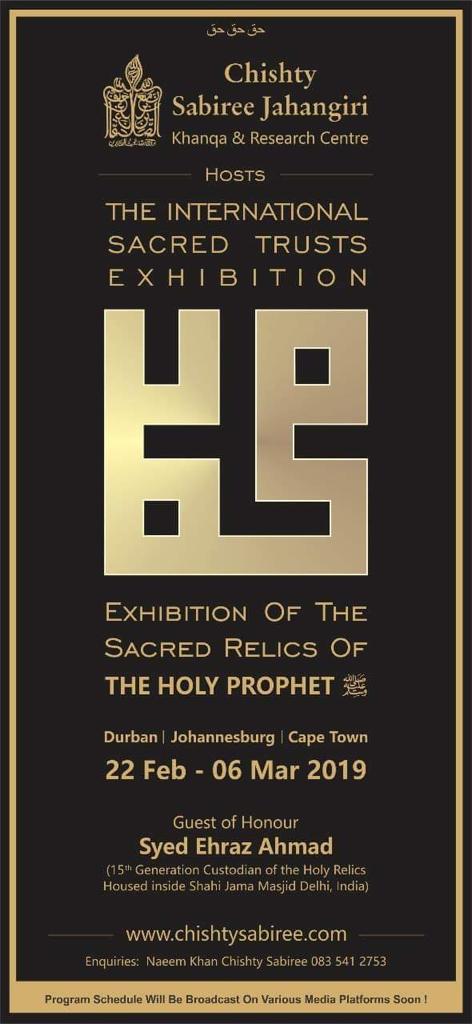FOR the first time in its 367-year history, the Muslim community will be able to view priceless relics of the Prophet Muhammad, various historical items that date back 1,440 years to his lifetime. This is the legacy of a friendship between a custodian of these relics, Sayyid Ahmad Ehraz of Delhi and the Chishty Sabiree Research Centre of South Africa.
Sayyid Ahmad, a direct descendant of the Prophet, hails from a family that has been custodians of these relics for 15 generations – and since the 17th century – at the magnificent Shah Jame’ah Mosque in Delhi, where they have been on display in a special viewing room.
Due to a warm relationship with South Africans visiting the mosque in Delhi, Sayyid Ahmad paid a visit to South Africa last year. During his stay, Sayyid Ahmad had said that the relics should never be hidden away, but that they should be available for all to see, as they carried the blessings of a Prophet who came as mercy to all mankind.
As a result, Cape Town – via the efforts of the Chishty Sabiree Research Centre – will host an exhibition of the historical relics entitled the “Sacred Trusts Exhibition” from 4-6 March. The public will be able to view them, free of charge, at the Al Kaaf Human Rights Centre in District Six. According to spokesperson and director of the centre, Anwah Nagia, the event will be jointly hosted by several Muslim organisations.

The exhibition, the first of its kind in South Africa which will also travel to KwaZulu Natal and Gauteng, marks the close relationship that the people of Cape Town have always had with the family of the Prophet.
Meccan families – such as the Kutbis and Safis – married into the Cape Town community, or enjoyed long-lasting relationships due to the Hajj, the major pilgrimage, when the Sayyids – prophetic descendants – would act as hosts and guides in the holy sanctuaries of Mecca and Medina. They would sail by steamboat to Cape Town to fetch their pilgrims and take them back to the port of Jeddah, where a two-day camel ride lay in wait for them en route to Mecca.
According to historians, many of Cape Town’s most distinguished political exiles of its early colonial years were themselves descendants of the Prophet. Tuan Sayyid ‘Alawi, who lies buried in the Tana Baru above the Bo Kaap, was related to the Prophet as was Sayyid Abd ul-Rahman Matarah, whose tomb is on Robben Island.
Imam ‘Abdullah ibn Qadi ‘Abd ul-Salam, who arrived in the Cape Colony from Tidore in 1780, and known as Tuan Guru and the founder of South Africa’s first mosque, is another descendant of the Prophet, his grandfathers travelling from Hadhramaut in Yemen to Oman, to India, to Cambodia and across the China Sea to Indonesia. In fact, one of Tuan Guru’s ancestors – Sharif Hidayatullah – is one of the founders of Islam in Java.
Shaykh Abu Bakr Effendi, the Ottoman scholar who was sent by the Sultan to help educate the Cape Muslim community in the 1860s, was also a descendant of the Prophet. And in the 1920s, when the Wahhabi invaders forced the Sayyids to flee the Arabian Peninsula, many took refuge in Cape Town, where Shaykh Muhammad Salih of the Azzawia took them under his wing.
It is in the spirit of this proud legacy that the exhibition is hosted by the community for the community, says Nagia.
The items on display are extensive. They range from a hair of the Prophet, to one of his sandals, a cloak, the piece of another cloak that has a miraculous smell of musk (said to be the scent of the Prophet himself), a piece of the Prophet’s turban, dust from his grave and an ancient lock used on his burial place in Medina’s Grand Mosque.
Nagia said that to accommodate the public and to maximise the rare opportunity of seeing Prophetic relics, special provisions had been made to ensure the exhibition would be open 24 hours. He said that the relics would be displayed in the same fashion as at the famous Topkapi Palace in Istanbul.
As at Topkapi, there would be teams of local Qaris reciting the Qur’an in the exhibition room, something which is designed to create a stately and sanctified atmosphere. Nagia confirmed that the relics had been fully authenticated, and that the Muslim Judicial Council, the Islamic Council of South Africa, the Islamic Unity Council and other religious bodies had endorsed the exhibition.
He said that for the community to be able to host such an exhibition was a humbling experience, and that South Africa should be proud to have been honoured to present such a unique and sacred exhibition of relics that were once part of one of humankind’s greatest historical figures.






 WhatsApp us
WhatsApp us 

